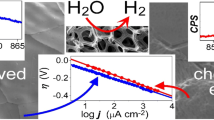Abstract
This paper reports on an investigation involving water content, water properties and proton conductivity in nanoporous TiO2 materials fabricated through sol-gel processing techniques. TiO2 nanoparticles having a primary particle diameter of less than 5 nm are packed into xerogels at room temperature and at 50∘C. The resulting xerogels are fired at temperatures of 200, 300 and 400∘C to alter the structural properties of these materials. Further alteration in the surface chemistry of the pore walls of these materials are made by equilibrating these porous wafers at pH 1.5 and 4.0 using nitric acid. Porosity, pore size, and surface area are evaluated with nitrogen adsorption techniques. Water content is calculated using data from thermogravimetric methods and water adsorption isotherms. Proton conductivity is measured using impedance spectroscopy. Of all variables affecting water content, water structure, and proton conductivity, the pH of pre-equilibrating the fired xerogels is the most important. However, porous structures of TiO2 arising from the open packing of nanoparticles, that have less tortuosity, are substantially different in the uptake of water with relative humidity than samples obtained from the close-packing of these same particles regardless of firing temperature. Also, the material with the smallest pore size (a close-packed structure fired at 200∘C) has the highest proton conductivity when measured between 20–60% relative humidity making this system the most favorable in terms of proton exchange membrane systems. Lastly, it is interesting to note that the density of water in these pores can vary between 1.2 and 1.6 g/l which is different than the 1.0 g/l of bulk water. This result likely comes from a combination of surface charge and surface roughness that affects the structure of interfacial water. These findings have importance not only for proton exchange membrane systems but also for other membrane technologies, cements, sensors, fabrication of wetting surfaces and in other areas that might benefit from the use of nanoporous materials.
Similar content being viewed by others
References
K.A. Mauritz and R.M. Warren, Macromolecules 22, 1730 (1989).
S.P. Nunes, B. Ruffmann, E. Rikowski, S. Vetter, and K. Richau, J. Membrane Sci. 203, 215 (2002).
S. Li and M. Liu, Electrochim. Acta 48, 4271 (2003).
Y.S. Kim, F. Wang, M. Hickner, T.A. Zawodzinski, and J.E. McGrath, J. Membrane Sci. 212, 263 (2003).
S. Malhotra and R. Datta, J. Electrochem. Soc. 144, 123 (1997).
B. Tazi and O. Savadogo, Electrochim. Acta 45, 4329 (2000).
B. Tazi and O. Savadogo, J. New Mater. Electrochem. Systems 4, 187 (2001).
G. Alberti and M. Casciola, Annu. Rev. Mater. Res. 33, 129 (2003).
S.M. Haile, D.A. Boysen, C.R.I. Chisholm, and R.B. Merle, Nature 410, 910 (2001).
R.B. Merle, C.R.I. Chisholm, D.A. Boysen, and S.M. Haile, Energy Fuels 17, 210 (2003).
F.M. Vichi, M.T. Colomer, and M.A. Anderson, Electrochem. Solid State Lett. 2, 313 (1999).
F.M. Vichi, M.I. Tejedor-Tejedor and M.A. Anderson, Chem. Mater. 12, 1762 (2000).
Q. Xu and M.A. Anderson, Mater. Res. 6, 1074 (1991).
I.I. Salame and T.J. Bandosz, Langmuir 15, 3632 (1999).
Y.M. Chiang, D. Birnie III, and W.D. Kingery, Physical Ceramics: Principles for Ceramic Sciences and Engineering (John Wiley and Sons, New York, 1997).
F. Roquerol, J. Roquerol, K. Sing, Adsorption by Powders and Porous Solids (Academic Press, Yew York, 1999), Chap. 1.
P.I. Ravikovitch, D. Wei, W.T. Chueh, G.L. Haller, and A.V. Neimark, J. Phys. Chem B. 101, 3671 (1997).
L.D. Tickanen, M.I. Tejedor–Tejedor, and M.A. Anderson, Langmuir 13, 4829 (1997).
L.K. Iler, The Chemistry of Silica (John Wiley and Sons, New York, 1979), Chap. 6
N. Bonanos, B.C.H. Steele, E.P. Butler, W.B. Johnson, W.L. Worrel, D.D. Macdonald, and M.C.H. McKubre, Impedance Spectroscopy, edited by J.R. Macdonald (John Wiley and Sons, New York, 1987).
Author information
Authors and Affiliations
Corresponding author
Rights and permissions
About this article
Cite this article
Tejedor-Tejedor, M.I., Vichi, F.M. & Anderson, M.A. Effect of Pore Structure on Proton Conductivity and Water Uptake in Nanoporous TiO2. J Porous Mater 12, 201–214 (2005). https://doi.org/10.1007/s10934-005-1649-9
Received:
Revised:
Issue Date:
DOI: https://doi.org/10.1007/s10934-005-1649-9




